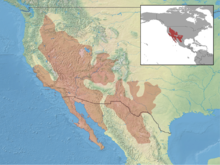Common Side-blotched Lizard
| Common side-blotched lizard | |
|---|---|
 |
|
| Scientific classification | |
| Kingdom: | Animalia |
| Phylum: | Chordata |
| Class: | Reptilia |
| Order: | Squamata |
| Suborder: | Iguania |
| Family: | Iguanidae |
| Subfamily: | Phrynosomatinae |
| Genus: | Uta |
| Species: | U. stansburiana |
| Binomial name | |
|
Uta stansburiana Baird & Girard, 1852 |
|
| Subspecies | |
|
|
 |
|
| Synonyms | |
|
|
The common side-blotched lizard (Uta stansburiana) is a species of side-blotched lizard found on the Pacific Coast of North America. It is notable for having a unique form of polymorphism wherein each of the three different male morphs utilizes a different strategy in acquiring mates. The three morphs compete against each other following a pattern of rock, paper, scissors, where one morph has advantages over another but is outcompeted by the third.
The specific epithet stansburiana is in honor of Captain Howard Stansbury of the US Corps of Topographical Engineers, who collected the first specimens while leading the 1849-1851 expedition to explore and survey the Great Salt Lake of Utah.
The systematics and taxonomy of these widespread and variable lizards is much disputed. Countless forms and morphs have been described as subspecies or even distinct species.
The common side-blotched lizard is a species of small iguanid lizard. Males can grow up to 60 mm (2.4 inches) from snout to vent, while females are typically a little smaller. The degree of pigmentation varies with sex and population. Some males can have blue flecks spread over their backs and tails, and their sides may be yellow or orange, while others may be unpatterned. Females may have stripes along their backs/sides, or again may be relatively drab. Both sexes have a prominent blotch on their sides, just behind their front limbs. Coloration is especially important in common side-blotched lizards, as it is closely related to the mating behavior of both males and females.
Male side-blotched lizards exhibit distinct polymorphism in their throat colors, and can be divided into three different categories. Each of these three different morphs varies in how it competes for mates, and variation within a breeding population is maintained by a rock-paper-scissors mechanism of frequency-dependent sexual selection. A cycle is created where the least common morph of one breeding season often has the largest number of mature living offspring in the next year. This is because one morph does particularly well against another, but poorly in comparison to the third.
...
Wikipedia
